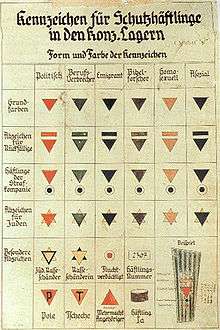Black triangle (badge)

The black triangle was a badge used in Nazi concentration camps to mark prisoners as "asocial" or "arbeitsscheu" (work-shy). It was later adopted as a lesbian or feminist symbol of pride and solidarity, on the assumption that the Nazis included lesbians in the "asocial" category. More recently it has been adopted by UK disabled people's organisations responding to increasing press allegations that disabled benefit recipients are workshy.
Nazi usage
The symbol originates from Nazi concentration camps, where every prisoner had to wear one of the Nazi concentration camp badges on their jacket, the color of which categorized them according to the reason for their internment. Individuals deemed "asocial" had to wear the Black Triangle. Many Black Triangle prisoners were either mentally disabled or mentally ill. The homeless were also included, as were alcoholics, the habitually "work-shy," prostitutes, and others (including draft dodgers and pacifists).[1]
Use by lesbians
| LGBT symbols | ||||||||
|---|---|---|---|---|---|---|---|---|
|
|
||||||||
Lesbians have over time claimed the black triangle as a symbol of defiance against repression and discrimination, and it is considered a counterpart to the gay pink triangle. Lesbians in Germany and the United States began using the black triangle as a pride symbol in the 1980s.
Controversy over the symbol's use

The use of the symbol as a sign of lesbian victimization has been challenged on the grounds that lesbian sex was not criminal under Paragraph 175 of the Nazi legislation on sexual behavior, and there is no record of the black triangle having been imposed on lesbians, or of lesbians as a group being confined to concentration camps. The archive of the memorial site of Ravensbrück has evidence of four women with an additional remark of being lesbians: two of them had been persecuted for political reasons, two for being Jewish. One of the Jewish inmates was given a black triangle due to sexual contacts with non-Jews.[2]
It is possible that Playing for Time ('Sursis pour l'orchestre'), a holocaust memoir by Frenchwoman Fania Fénelon, helped create the belief that the black triangle was worn by lesbians. Fénelon's memoir includes lesbian themes and describes an evening of entertainment in the asocials' barracks as the "Black Triangles' Ball."
Use by disabled peoples' organisations
Some UK groups concerned with the rights of disabled people have adopted the symbol in their campaigns.[3][4] Such groups cite press coverage and government policies, including changes to incapacity benefit and disability living allowance, as the reasons for their campaigns.[5][6]
See also
- Action T4
- Anti-homelessness legislation
- Discrimination against the homeless
- Persecution of homosexuals in Nazi Germany and the Holocaust
- LGBT symbols
References
- ↑ The unsettled, "asocials", alcoholics and prostitutes. Center for Holocaust & Genocide Studies. University of Minnesota. Retrieved September 14, 2012.
- ↑ Claudia Schoppmann, Nationalsozialistische Sexualpolitik und weibliche Homosexualität (Dissertation, FU Berlin, 1990.), Centaurus, Pfaffenweiler, 1991 (revisited 2nd edition 1997). ISBN 3-89085-538-5
- ↑ Black Triangle Campaign
- ↑ http://www.dpac.uk.net/
- ↑ http://blacktrianglecampaign.org/2011/12/20/no-disability-living-allowance-for-me-nowhere-to-turn-for-many-more/
- ↑ http://blacktrianglecampaign.org/2011/12/13/britains-press-are-fighting-a-class-war-defending-the-elite-they-belong-to/
Further reading
- Elman, R. Amy. "Triangles and Tribulations: The Politics of Nazi Symbols," Journal of Homosexuality, vol. 30, no. 3 (1996): 3-11.
- Marshall, Stuart. "The Contemporary Use of Gay History: The Third Reich," in Bad-Object Choices (ed.), How Do I Look? Queer Film and Video, Seattle, Wash.: Bay Press, 1991.
- Zoe, Lucinda. "The Black Triangle," Lesbian Herstory Archives Newsletter, Brooklyn, N.Y., No. 12 (June 1991): p. 7. (A critical discussion of the notion that black triangles were used to mark lesbians in the concentration camps in a manner equivalent to the pink triangle for homosexual men, along with remarks on when the black triangle came to be used as a contemporary lesbian symbol).